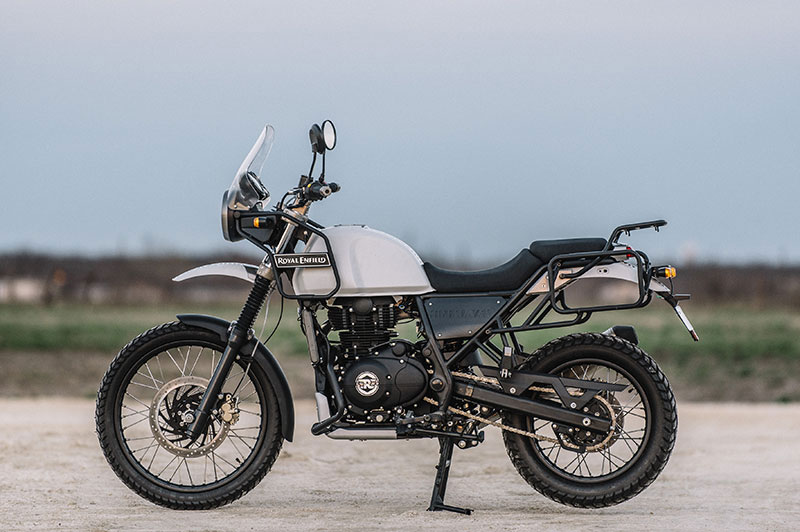2018 Royal Enfield Himalayan

First Ride Review
To understand the Royal Enfield Himalayan motorcycle, you need a little appreciation for the motorcycle market in India, where RE is based in Chennai. First, it’s ridiculously huge. More than a third of the country’s 1.3 billion inhabitants own a motorized two-wheeler, and the top-10 Indian motorcycle manufacturers bang out more than 1 million motorcycles per month. No horsepower wars there, though—of those million-plus, three-quarters are 150cc or smaller. Utility reigns supreme, and low cost, fuel efficiency and maneuverability sell far more bikes than power or luxury.
Outside of the hirsute commute in Indian cities, literally hundreds of tour groups—including Royal Enfield’s own Rides program—make adventurous treks by motorcycle up into the Himalayas in the far north and Nepal next door, braving treacherous dirt roads, extreme temperatures and passes at more than 18,000 feet because…well, because it’s there. In the U.S., Royal Enfield’s Bullet and Classic 500s are considered quirky retro machines and would never be used as dual-sports. In India though, perhaps because the brand has been around longest, or perhaps because its two-valve, air-cooled singles and stone-simple chassis and running gear are easily repaired roadside, Royal Enfield 350 and 500 singles are by far the most popular bike for slowly but surely clawing and scratching up into the mountains. They don’t go fast…they just go.
Once in danger of being sold off by its parent company Eicher Motors in the late ’90s, Royal Enfield is now on its way to becoming the world’s largest producer of middleweight motorcycles, growing 50 percent every year for the last six and opening new factories and technical development centers in India and the UK. In 2010 RE built and sold about 40,000 motorcycles; in 2018 that number will grow to at least 850,000. A pair of new 650 twins—the Interceptor and Continental GT—are coming to the U.S. lineup early next year, and RE says that more new engines and platforms will follow.
In that expansive environment, when some of the RE team noticed Bullet and Classic single owners modifying their bikes to better suit the rugged environment of the Himalayas, it was decided RE should build its own adventure bike, and the Himalayan was born. Originally designed just for India—with no pretense of competing with the likes of big, expensive ADV machines overseas—Royal Enfield North America (RENA) President Rod Copes nevertheless recognized the bike’s potential in our growing ADV bike market and convinced RE India to homologate the Himalayan for the U.S. Making the bike acceptable to our EPA and DOT with Keihin electronic fuel injection, different lighting and instruments, reflectors, etc., added a few pounds, but otherwise the compact bike is the same one taking riders over insane passes in the Himalayas like Rohtang and Thorong La.
Even with these upgrades, the Himalayan is simple, fun and approachable, and its $4,499 price tag undercuts competition like the BMW G 310 GS (also made in India) and Kawasaki Versys-X 300 by as much as $1,200. With a claimed 24.5 horsepower at its redline of 6,500 rpm, the Himalayan’s SOHC, 2-valve 411cc single makes fewer ponies than those rev-happy bikes, but it was designed with a long stroke to crank out 26 lb-ft of torque, significantly more than the BMW or Kawi. This low-end grunt makes the 421-pound, fully gassed bike adept at climbing hills, churning up a rocky riverbed in a higher gear at low speed or squirting though traffic. Accessible screw-and-locknut valve adjusters simplify maintenance, and a gear-driven counterbalancer in the 5-speed LS 410 engine reduces vibes to just a mild pulse feel in the grips. Royal Enfield says its quality control issues of the past are under better control thanks to its new facilities in India, and because RENA makes a pre-delivery inspection of every bike at its PDI center in Texas before shipping them to dealers.
UK-based Harris Performance, which designs and manufactures road and racing motorcycle chassis and components (and was recently acquired by Eicher Motors), developed the Himalayan’s half-duplex split-cradle steel frame, Royal Enfield’s first with linked single-shock rear suspension. In addition to carrying luggage in back and a generous load capacity, major goals were to have both a low enough seat that the average Asian rider could plant both feet on the ground and plenty of suspension travel. Even with its relatively low 31.5-inch seat height—which feels much lower when you straddle the bike because of its narrow side panels—there’s still 7.9 inches of travel in front and 7.1 rear, and a generous 9 inches of ground clearance. Seating is upright and relaxed, with a high, wide handlebar and lowish footpegs that drag easily in turns but make standing up quick and easy. Larger riders will probably find the seat overly soft and seating a bit cramped on the smaller-scale ADV bike, but at 5-feet, 10-inches it fit me just fine.
Royal Enfield launched the Himalayan in Midlothian, Texas, at TexPlex, a 1,000-plus-acre facility with lots of adult toys like earthmovers, jet boats and MX tracks as well as a large off-road riding circuit that was a good test of the Himalayan’s dirt capabilities. First we made a 1-hour on-road ride on back roads, winding through bucolic countryside past horse farms and barns. For 411cc the Himalayan holds it own well, with enough power to accelerate quickly into top gear on the Interstate and merge with traffic up to about 75 mph, where it runs out of steam. At lower speeds there’s just enough power to make quick passes and out-gun traffic—the bike feels very similar power-wise to a mid-1970s Honda XL350, in fact, but far smoother, and the EFI gives it good throttle response and a claimed 70 mpg, for a range from its 4-gallon tank of more than 250 miles. It would be a stretch to tackle our 80-plus mph Interstates in the U.S. for very long, especially in high-volume areas like Southern California, but the bike is OK for jumping on and off them and cruising saner highways and backroads.
Suspension front and rear is made in India and is quite capable on-road and off, soaking up small bumps and big potholes without any drama and helping me ride the bike pretty quickly on the off-road course. Big G-outs would bottom the rear shock, but I couldn’t adjust the rear preload setting, which was only on the third of seven. Brakes are from ByBre, an Indian division of Brembo in Italy, and both the 300mm disc with 2-piston floating caliper up front and 240mm, 1-piston setup in back bite smoothly and strongly, with moderately high effort required in front typical of dual-sports. ABS is probably in our future since Europe and Australia already get it, but don’t look for traction control anytime soon. The Himalayan comes with excellent Pirelli MT 60 dual-sport tires that gripped both pavement and the near-perfect loamy soil (read: no sand) of the off-road course very well, and the 21-inch front wheel helps the bike roll over ruts and rocks and bite better in turns off-road. Overall this is a versatile, comfortable machine ready to take on mini adventures of any type or a short commute at street-legal speeds.
The bike’s sturdy frame is designed to support hard bags in back, and along with an aluminum pannier kit, Royal Enfield will offer an aluminum handlebar, bar-end weights and an engine guard as accessories for the Himalayan when it hits RE’s 75 dealers in April. There’s a small amount of storage underneath the locking seat, the steel tank will easily hold a magnetic tank bag and a luggage rack is standard. I do wish the brake and clutch levers were adjustable, and the bike lacks hand guards, though the Himalayan does come with a robust skidplate, centerstand and both high and low front fenders, the latter of which can be easily removed. That flyscreen does a great job of protecting the rider’s upper body, too, and enhances comfort over time. Royal Enfield definitely did its ADV bike homework in designing the Himalayan for long rugged rides…or should I say much of its homework was done for it by the thousands of riders who have conquered the Himalayas on its motorcycles, and will now do so on this one.
It’s easy to poke fun at this no-frills motorcycle as being too slow, too small or too low-tech for the American rider. But take a look at the typical megabucks Euro or Japanese ADV slathered with electronics the average rider will never use or understand, that is often too tall and too heavy for him/her to ride off-road, never mind pick up, and the Himalayan starts to make a lot of sense. While you may not get there very fast, you are going to get there….

